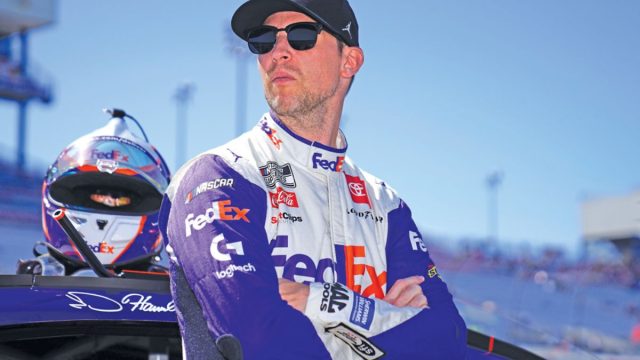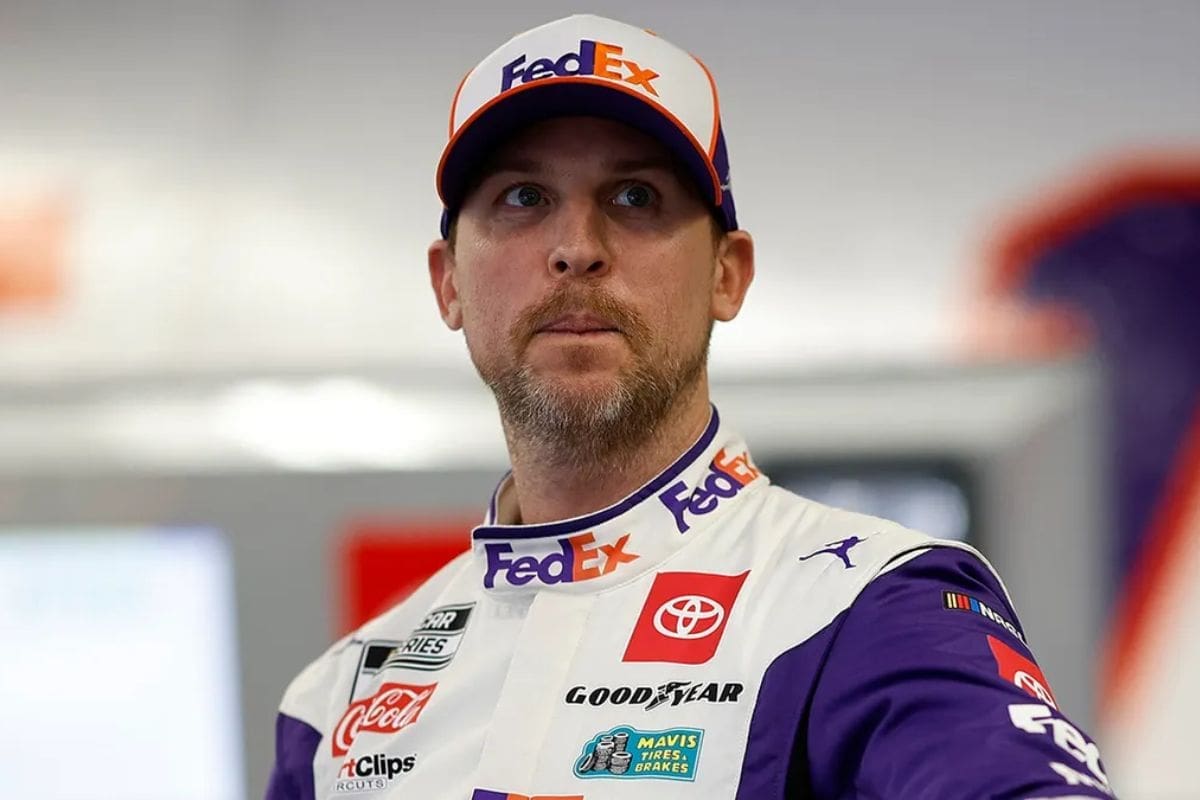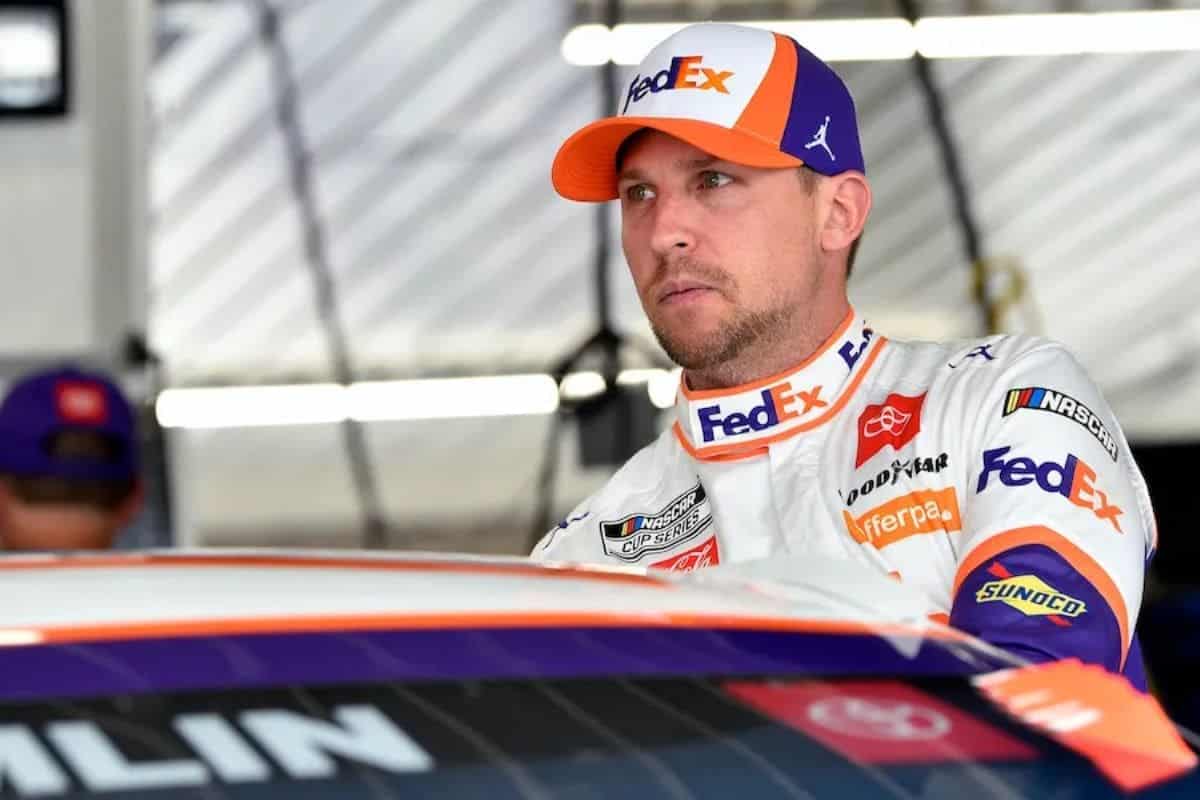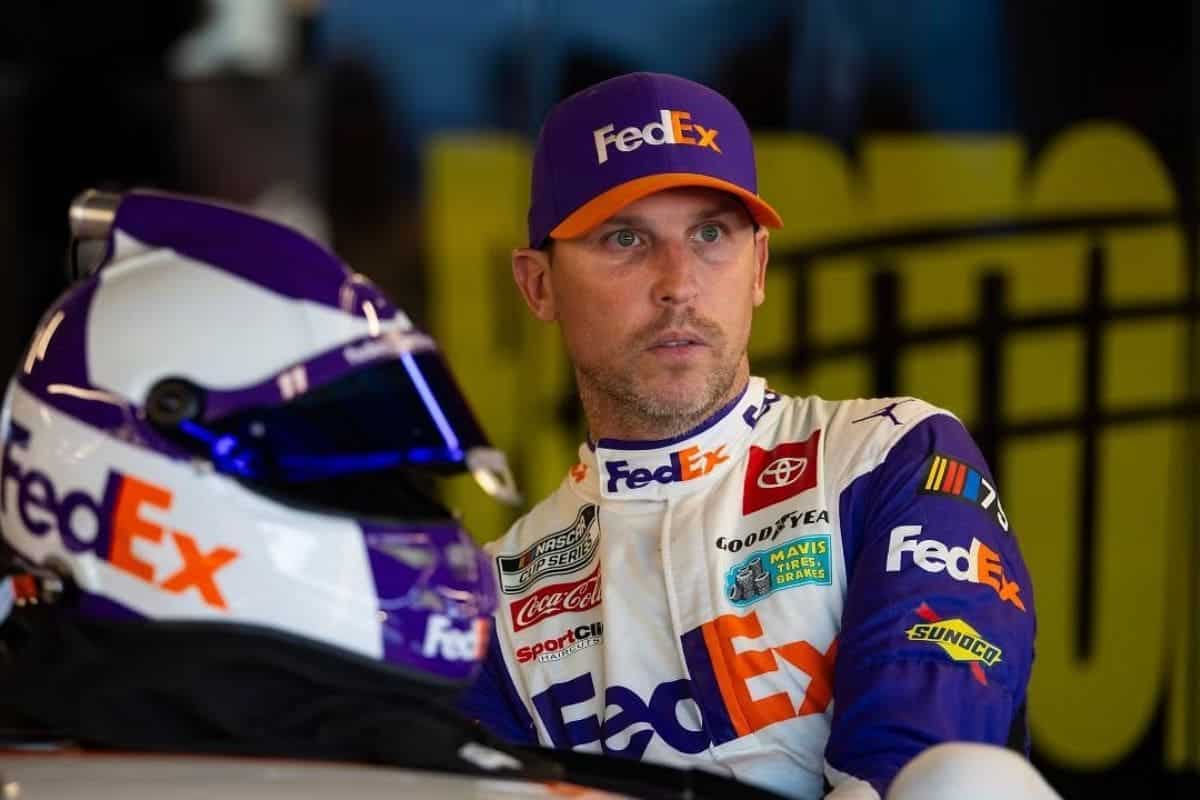Denny Hamlin’s Tactics Spark NASCAR Warning: Denny Hamlin’s recent victory in Toyota Owners 400 has sparked a tempest of controversy within NASCAR, centered on his tactics during the critical final restart. Facing scrutiny, Hamlin acknowledged an early move, highlighting the fine line between strategic ingenuity and regulatory infringement. NASCAR’s investigation into the incident, focusing on speed and positioning, scrutinizes the balance between strict rule adherence and the dynamic nature of racing. Despite NASCAR VP’s initial defense of Hamlin’s actions, reflections and subsequent warnings hint at a newfound readiness to reassess and possibly tighten regulations. This controversy shows the complex interplay between strategy, integrity, and enforcement in NASCAR, inviting further scrutiny into the variations of competitive racing dynamics.
Key Takeaways
- NASCAR investigated Denny Hamlin’s final restart actions for potential rule violations at Richmond.
- NASCAR VP reflected on the decision, suggesting reconsideration of potential penalties for Hamlin.
- Hamlin admitted to an early move in the final restart, sparking debate on enforcement practices.
- The controversy questions NASCAR’s consistency and fairness in rule enforcement.
- The incident emphasizes the balance between strategic racing and adherence to regulations.
Controversy Surrounding Denny Hamlin’s Victory
Denny Hamlin’s recent triumph in Toyota Owners 400 has been surrounded by controversy, stemming from tactics on the pit road that many argue could have unfairly tilted the scales in his favor, raising questions about the fairness and integrity of the competition. The debate centers on whether Martin Truex Jr. might have secured the victory had Hamlin faced penalties for his actions during the race. This situation has sparked a fervent discussion among stakeholders about the variations of NASCAR’s rules and the enforcement thereof.
NASCAR’s Vice President’s clarification on the decision not to penalize Hamlin has further fueled the discourse, highlighting a gap between the expectations of fans, participants, and what the NASCAR rulebook dictates. The decision was accompanied by a stern warning regarding Hamlin’s future conduct on the track, suggesting that while his actions may not have crossed the threshold for penalty this time, the margin for such maneuvers is narrowing.
This incident shows a broader issue within motor racing – the balance between strategic ingenuity and the integrity of the sport. Hamlin’s tactics, whether seen as a stroke of genius or a questionable move, exemplify the fine line on which competitors operate. It raises crucial questions about where the boundary should be drawn between exploiting regulatory grey areas and outright rule-breaking, and how such distinctions impact the sport’s credibility.
Furthermore, the controversy serves as a reminder of the complexities involved in enforcing sporting regulations. It emphasizes the need for clarity and consistency in the rulebook to maintain the competitive balance and ensure that victories are unquestionably earned on merit, not ruined by doubt or debate over legal technicalities.
NASCAR’s Investigation into Hamlin’s Restart
Amidst the ongoing controversy regarding Denny Hamlin’s tactics, NASCAR has initiated an investigation into his actions during the final restart of the Richmond race. The scrutiny centers on whether Hamlin’s maneuver in his #11 car, which catapulted him past his teammate Martin Truex Jr.—who had been leading for over 200 laps—violated the sport’s restart rules. This probe highlights NASCAR’s commitment to maintaining competitive integrity and the complexities involved in enforcing restart regulations.
NASCAR’s inquiry into Hamlin’s restart is not merely about exploring whether a rule was broken but looks into the intricacies of how restarts are policed and the consistency of rule application. This investigation brings to light the delicate balance that NASCAR must maintain between allowing drivers to race aggressively and ensuring a level playing field. The outcome of this investigation could have far-reaching implications for how races are conducted and how closely drivers adhere to the restart guidelines.
Moreover, this situation shows the critical role of race officials in interpreting actions in real-time and the potential for post-race analyses to alter perceptions of fairness and sportsmanship. As NASCAR analyzes the specifics of Hamlin’s restart, the broader implications for the sport’s regulatory framework and its enforcement mechanisms remain a key point of interest for fans and participants.
NASCAR VP’s Response and Evaluation
Addressing the controversy surrounding Denny Hamlin’s final restart during the Richmond race, Elton Sawyer, NASCAR’s Vice President of Competition, acknowledged the fans’ concerns but ultimately deemed Hamlin’s actions as falling within the acceptable parameters of the sport’s rules. This decision came after a thorough review process that saw NASCAR officials closely analyzing the variations of the race’s final moments. The scrutiny was not taken lightly, reflecting NASCAR’s commitment to fairness and the maintenance of competitive integrity within the sport.
Sawyer’s evaluation process involved a detailed examination of race footage, alongside the application of NASCAR’s intricate rule set governing restarts. This analysis was critical in determining whether Hamlin’s maneuver constituted a violation. The key factor in this determination was whether Hamlin’s actions could be definitively classified as a ‘jump start,’ a term that carries significant implications within NASCAR’s regulatory framework. The conclusion that Hamlin’s restart was complied with the rules’ shows the complexity and subjectivity inherent in officiating such high-stakes moments.
The decision to allow Hamlin to retain his victory indicates a distinct understanding of the sport’s regulations, emphasizing the importance of context in interpreting actions on the track. It also reflects NASCAR’s broader approach to rule enforcement, which seeks to balance strict adherence to the letter of the law with an appreciation for the dynamic nature of racing. This incident, and NASCAR’s response to it, highlights the ongoing dialogue between the sport’s governing bodies and its participants, ensuring that the competitive spirit of NASCAR remains vibrant and unimpeded by overly rigid interpretations of its rules.
Sawyer’s Reflection and Warning
In a recent revelation during his SiriusXM NASCAR interview, Elton Sawyer, NASCAR’s Vice President of Competition, expressed second thoughts regarding the decision not to penalize Denny Hamlin, suggesting a potential oversight in the initial judgment of the Richmond race’s final restart. Sawyer’s reflection on the situation shows the distinct and often intricate nature of NASCAR’s rule enforcement, particularly in high-stakes moments such as race restarts. The reconsideration of Hamlin’s actions shows a broader discourse on the consistency and transparency of NASCAR’s penalization process.
Sawyer’s commentary not only sheds light on the specific incident involving Hamlin but also serves as a cautionary tale for drivers and teams. The potential oversight at the Richmond race signals a warning that NASCAR is willing to reassess and possibly reevaluate its judgment in the face of new evidence or upon reflection. This stance by NASCAR is indicative of a commitment to fairness but also introduces unpredictability in the enforcement of rules.
The implications of Sawyer’s admission are multifaceted. It opens the door to a more dynamic interpretation of race incidents, where decisions could be revisited as insights evolve. Additionally, it emphasizes the necessity for drivers to operate within the confines of the established regulations, knowing that their actions are subject to scrutiny, not just in the moment, but in the aftermath of the race. This reflective approach by NASCAR’s leadership aims to enhance the integrity of the sport, ensuring that competition remains at the heart of every decision.
“And as I looked at it yesterday, again, multiple times, there’s no doubt he rolled early. And again it’s a bang-bang call it’s at the end of the race You know, we’re a live sporting event. We don’t have the… luxury of a timeout and go to the sideline and review it and make that call. If this happens at lap 10 or 50 or 300 you know, the call could have been different.” – (Elton)
🗣️ "There's no doubt he rolled early."#NASCAR's Elton Sawyer explains the decision to not penalize @dennyhamlin in the moment for jumping the restart Sunday at @RichmondRaceway.
— SiriusXM NASCAR Radio (Ch. 90) (@SiriusXMNASCAR) April 2, 2024
Full Interview → https://t.co/WGRTG5gVtL pic.twitter.com/HOJXoPBaAw
Hamlin’s Admission and Defense
Reflecting on Elton Sawyer’s reconsideration of the penalty decision, Denny Hamlin openly acknowledged his early move in the final restart, sparking a nuanced debate over NASCAR’s enforcement practices. Hamlin’s candid admission on his podcast, stating, ‘I went pretty early in the zone,’ has thrust the spotlight on NASCAR’s oversight mechanisms, raising questions about consistency and fairness in race officiating.
Hamlin’s defense of his actions reveals a complex landscape of unwritten rules and tacit understandings among drivers and officials. He suggests that NASCAR’s historically lenient approach to restarts has set a precedent, one that all drivers navigate to maximize their advantage. This stance offers a glimpse into the strategic underpinnings of professional racing, where the boundaries of regulation and competitive edge blur.
Hamlin didn’t just stir the pot and vanish; he stuck around to lay out his perspective. According to him, NASCAR has been relatively lenient regarding how drivers approach the restart box. He contends that if NASCAR suddenly tightened the reins, numerous wins would come under scrutiny and potentially warrant a redo. In the high-pressure moments of the Cup Series, everyone is well aware of the protocols when it comes to restarts.
Hamlin analyzed the intricacies of being behind the wheel, shedding light on the strategic variations of timing your start. He emphasized that predictability can be a driver’s downfall, as the competitor trailing you might seize the opportunity to make a move and gain an advantage. It’s a delicate balance of anticipation and reaction, where split-second decisions can make all the difference in the fiercely competitive sport of NASCAR.
News in Brief
The controversy surrounding Denny Hamlin’s victory shows the distinct complexities inherent in motorsports regulation and enforcement.
NASCAR’s investigation into Hamlin’s restart, accompanied by the organization’s VP’s evaluative response, illustrates the delicate balance between strategic ingenuity and regulatory compliance.
Sawyer’s reflection and subsequent warning, coupled with Hamlin’s own admission and defense, highlight a pivotal moment in racing oversight.
This episode serves as a critical case study in the ongoing dialogue between innovation in competitive tactics and the imperative of maintaining sporting integrity within the motorsports domain.
Our Reader’s Queries
Q. What is Denny Hamlin driving?
A. James Dennis Alan Hamlin, born on November 18, 1980, is a prominent figure in American stock car racing. He serves as both a driver and team owner in the NASCAR Cup Series. Hamlin’s current endeavor involves full-time competition, where he pilots the No. 11 Toyota Camry XSE under the banner of Joe Gibbs Racing.
Q. What is Denny Hamlin known for?
A. Denny Hamlin, known for his prowess on the NASCAR circuit, commands the No. 11 Toyota under the Joe Gibbs Racing banner. Notably, he shares ownership of 23XI Racing with basketball icon Michael Jordan within the NASCAR Cup Series. Hamlin’s impressive track record boasts 53 victories, among them prestigious wins at the Coca-Cola 600 in 2022, and multiple triumphs at the Daytona 500 in 2016, 2019, and 2020. Additionally, he has clinched victories at the Southern 500 in 2010, 2017, and 2021, solidifying his status as a formidable force in the sport.
Q. Has Denny Hamlin ever won a road race?
Hamlin secured his inaugural road course triumph by leading a mere 10 laps out of the 90-lap race, yet they proved pivotal, especially in the race’s closing stages.
ALSO READ: Denny Hamlin’s Easter Mishap: Fiancé Foils Weekend Plans



